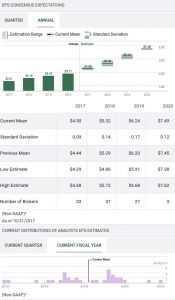Contents
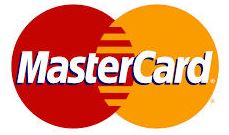 Summary
Summary
- This MasterCard stock analysis is based on Q3 2017 results released October 31, 2017 and the September 7, 2017 Investor Day presentation.
- MA and V are the two highest convictions stocks amongst the ~50 companies in which my wife/I own shares.
- MA likely gets overlooked by many investors because of its sub 1% dividend yield and short dividend history.
- MA has a robust suite of products/services and new offerings are continually being developed/acquired. I foresee continued growth over the long-term.
Introduction
On July 31, 2017 I wrote that:
- MasterCard (NYSE: MA) and VISA (NYSE:V) are two stocks I never intend to sell (other than to transfer them from registered to non-registered accounts as appropriate);
- I had recently acquired an additional 400 MasterCard shares in a Locked-in Registered Retirement Savings Plan.
On October 30th I provided my opinion on V’s Q3 results released October 25th. In this post I provide my opinion on MA’s Q3 results released October 31st.
Of all the companies in which we own shares, MA and V are my two highest convictions stocks.
In the event you are not entirely familiar with the full nature of MA’s business you may wish to review “Part 1, Item 1 – Business” in MA’s FY 2016 Form 10-K Annual Report. Pages 6 -16 of the 104 page pdf document provide an excellent overview of MA’s strategy, business, industry dynamics, revenue sources, competition, and (of course) the government regulation under which it must operate.
September 7, 2017 Investment Community Presentation
The first meaningful page of the presentation reflects the following chart.
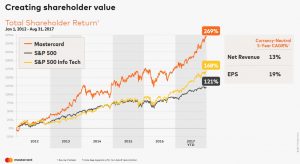 Source: MA September 7, 2017 Investment Community Meeting Presentation
Source: MA September 7, 2017 Investment Community Meeting Presentation
If this chart sparks any interest whatsoever, I strongly suggest you access the 83 page pdf presentation as I cannot possibly give it justice in this post.
In this presentation you will see what MA has identified as current and emerging trends, the magnitude of the growth potential, the extent to which highly sophisticated technological advances are opening new opportunities, an overview of the multiple geographic markets in which it competes, and its financial outlook.
Q3 2017 Financial Results
MA’s October 31, 2017 Q3 Earnings Release can be found here and its Earnings Presentation can be found here.
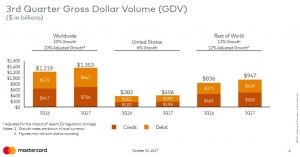
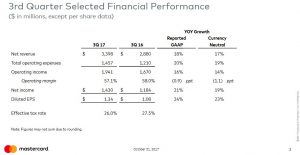 Source: MA October 31, 2017 Q3 Financial Results Presentation
Source: MA October 31, 2017 Q3 Financial Results Presentation
Outlook Raised
MA indicated in its September 7, 2017 Investment Community Presentation that it was revising upward its Net Revenue and EPS Compound Annual Growth Rates.
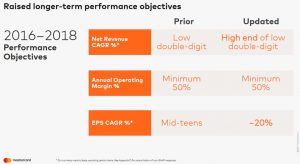 Source: MA September 7, 2017 Investment Community Meeting Presentation
Source: MA September 7, 2017 Investment Community Meeting Presentation
The investment community appears to have received the upward revisions well as MA’s stock price has appreciated ~$12 subsequent to the date of this presentation.
MasterCard Product Offering
MA offers a robust suite of products for multiple market segments using various payment technologies. If you are interested in learning about MA’s product/service offering you may wish to go here to select the services that are of interest to you.
Dividend, Dividend Yield, and Dividend Payout Ratio
MA has rewarded investors considerably with the following chart showing the magnitude of share repurchases and dividends in recent years.
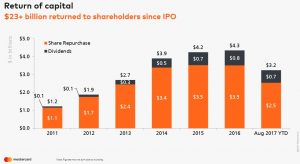 Source: MA September 7, 2017 Investment Community Meeting Presentation
Source: MA September 7, 2017 Investment Community Meeting Presentation
MA’s dividend history can be found here. The forthcoming November 9 th $0.22 quarterly dividend will be the 4 th in a row. I anticipate that in December 2017 MA will announce an increase to its quarterly dividend which will take effect with the February 2017 dividend; I envision a ~$0.03/quarterly dividend increase which is consistent with the previous two dividend increases.
Countless investors rely solely, or very heavily, on stock screeners to identify potential investments. With a sub 1% dividend yield and a reasonably short dividend history, MA is often automatically excluded from many search results. This highlights the shortcoming of relying exclusively on stock screeners to come up with a list of companies warranting further analysis.
Over the past several years, it appears investors have been willing to take on additional risk for the sake of gaining additional yield; it does not take long to find investments with lofty dividends and dividend payout ratios. These are the companies I view as most at risk of a major correction in valuation levels if the Fed and the Bank of Canada increase rates.
In the case of MA, investors have little to fear about a potential dividend cut. As previously noted, the dividend yield is sub 1%. Secondly, the dividend payout ratio is in the high teen/low 20 range. Thirdly, Free Cash Flow is strong.
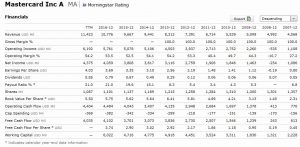 Source: Morningstar
Source: Morningstar
On December 6, 2016 MA announced a new $4B Class A common stock share repurchase program.
As at December 31, 2016, there was 1.1B Diluted Weighted-Average Shares Outstanding. As at September 30, 2017, 1.075B were outstanding. This compares favorably with ~1.26B in Diluted Weighted-Average Shares Outstanding as at the end of 2012.
Another 2 million shares at a cost of $0.286B were purchased October 1 – 26, 2017 thus leaving $2B remaining under the currently authorized repurchase program.
While a proposed £14 billion class action lawsuit against MasterCard has been revived, I expect MA intends to rigorously defend itself against all charges. I do not foresee this matter coming to any resolution in the short-term and fully expect MA to announce in early December 2017 a 2018 share repurchase program under similar terms to those announced in December 2016.
Valuation
Using the 2017 and 2018 EPS Consensus Expectations of $4.50 and $5.32 and the October 31, 2017 closing stock price of $148.77 we arrive at a PE and projected PE of 33.06 and 27.97.
My sentiments regarding MA’s valuation are identical to those mentioned in the valuation section of my recent V post.
You will very rarely find MA “on sale” (unless a market correction occurs). In my opinion, if you have a long-term investment time horizon, you may want to periodically acquire MA shares. Should the markets implode and MA experiences a dramatic drop in price you should seriously consider “loading up the truck”.
Cautionary Tale
NOTE: Please do not construe the following as tax advice. Your circumstances might be different from our situation and you may reside in a different tax jurisdiction. I am merely sharing our situation with you and suggest that expert advice be sought when determining how best to structure your investments for your specific circumstances.
Please give serious consideration to the type of account in which you hold your investments.
In our case we hold MA and V in tax advantaged accounts. The advantage of having held these shares in such accounts is that all growth and income has not incurred any tax liability to date. The disadvantage of having held these shares in such accounts is that all growth and income has not incurred any tax liability to date.
The dramatic growth in the value of these two holdings has certainly changed the complexion of our tax obligations relative to when these investments were originally made. At a certain stage we will need to convert our tax advantaged accounts from Registered Retirement Savings Plans to Registered Retirement Income Funds.
In the 2015 Canadian Federal budget, reductions were made to the minimum amount that must be withdrawn for a holder who is 71 to 94 years old; the new factors by age can be found here under question #3. This means you MUST withdraw funds from your Registered Retirement Income Funds and pay tax on these withdrawals regardless of whether you require the funds or not. In essence, the ability to hold the shares in perpetuity and to defer any capital gains tax is restricted by the Registered Retirement Income Funds rules.
We are now in a situation where we must implement a Registered Retirement Saving Plan meltdown strategy otherwise our tax burden is going to be onerous; we need to withdraw MA and V shares “in kind” from tax advantaged accounts for deposit into taxable accounts.
Let’s use an example where $100,000 in MA shares are being transferred from a tax advantaged account to a non-tax advantaged account.
Withholding tax would be calculated on a tiered structure. If there is sufficient cash in the tax advantaged account, this cash can be used to cover withholding tax thus allowing us to transfer the full $100,000 in MA shares to non tax advantaged accounts. If insufficient cash is held in the tax advantaged account, we would transfer MA shares “in kind” but would need to sell some other investments to ensure we have sufficient cash to cover the withholding tax obligations.
MasterCard Stock Analysis – Final Thoughts
I want to benefit from the global payment trends and I see owning shares in MA and V as a great way to accomplish this; I am not averse to periodically acquiring additional shares (within reason) in both companies despite their low dividend yield and habitually rich valuation.
I like the business model so much that if, I could, I would own shares in China UnionPay; it is not publicly traded so I cannot own shares.
This company operates China’s only national electronic payment network. It serves more than 400 financial institutions across the country and in Europe, Japan, Korea, Singapore, and other countries and regions. Since its formation in 2002, China UnionPay has had more than 2.1 billion cards issued under its brand.
Member banks like Bank of China, Agricultural Bank of China, and Citibank issue their own UnionPay-branded cards and use the company’s network to process credit and debit transactions in China.
I hope you enjoyed this post and I wish you much success on your journey to financial freedom.
Thanks for reading!
Note: I sincerely appreciate the time you took to read this post. As always, please leave any feedback and questions you may have in the “Contact Me Here” section to the right.
Disclaimer: I have no knowledge of your individual circumstances and am not providing individualized advice or recommendations. I encourage you not to make any investment decision without conducting your own research and due diligence. You should also consult your financial advisor about your specific situation.
Disclosure: I and long MA and V.
I wrote this article myself and it expresses my own opinions. I am not receiving compensation for it and have no business relationship with any company whose stock is mentioned in this article.


